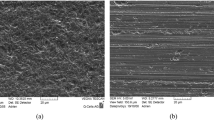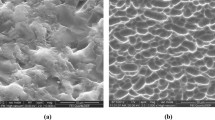Abstract
There are large brittle fracture pits on the surface of photovoltaic polysilicon wafer cut by diamond wire saw, because of the problems such as poor flow of cutting fluid and difficulty in chip discharge. At the same time, the anti-corrosion amorphous layer on the wafer surface can obviously block the subsequent acid etching and texturing reaction. In order to solve these problems, a new type of diamond abrasives-helix-distribution saw wire is used as the sawing tool to obtain the surface characteristics of photovoltaic polysilicon wafer suitable for acid texturing, then research on wire sawing photovoltaic polysilicon based on controlling subsurface microcrack damage depth control is carried out. The concept of high-quality cutting abrasives (HQCA) is defined, and the cutting process of polycrystalline silicon is numerically calculated based on the established new type diamond wire model, the influence of the process parameters and the structural parameters of the saw wire on the cutting characteristics is analyzed, and the reasonable matching between the process parameters and the saw wire parameters is discussed. The study results show that the number and proportion of HQCA in all abrasive grains involved in sawing can be increased by increasing the workpiece feed speed or reducing the moving speed of saw wire, properly reducing the abrasive concentration on the saw wire surface or increasing the abrasives size, or setting the ratio of axial distance between the abrasive area on wire surface and the bare wire area as 1:1. In this case, the formation of the wafer surface tends to be removed in the way of material microbrittleness, and the subsurface crack depths are in the optimal etching depth range. The number and proportion of HQCA remain basically unchanged when the workpiece feed speed changes in constant proportion to the wire speed, and the screw pitch of the abrasive groups on the surface of the saw wire has little effect on it.























Similar content being viewed by others
References
Luceño-Sánchez JA, Díez-Pascual AM, Peña-Capilla R (2019) Materials for photovoltaics: state of art and recent developments. Int J Mol Sci 20:976
Singh J, Agrahari A (2019) The progression of silicon technology acting as substratum for the betterment of future photovoltaics. Int J Energy Res 43:3959–3980
Kakimoto K, Gao B, Nakano S, Harada H, Miyamura Y (2017) Silicon bulk growth for solar cells: science and technology. Jpn J Appl Phys 56:20101
Pu TZ, Gao YF, Wang LY, Yin YK (2020) Experimental investigation on the machining characteristics of fixed-free abrasive combined wire sawing PV polycrystalline silicon solar cell. Int J Adv Manuf Technol 107(1):843–858
Li HS, Gao YF, Ge PQ, Bi WB, Zhang L (2020) Study on process parameters of fabrication fine diameter electroplated diamond wire for slicing crystalline silicon solar cell. Int J Adv Manuf Technol 106(7–8):3153–3175
Gao YF, Chen Y (2019) Sawing stress of SiC single crystal with void defect in diamond wire saw slicing. Int J Adv Manuf Technol 103(1):1019–1031
Möller HJ (2004) Basic mechanisms and models of multi-wire sawing. Adv Eng Mater 6:501–513
Ge MR, Gao YF, Ge PQ, Jiao Y, Bi WB (2017) A finite element analysis of sawing stress in fixed-abrasive wire saw slicing KDP crystal. Int J Adv Manuf Technol 91(5–8):2049–2057
Wang NC, Jiang F, Xu XP, Duan N, Wen QL, Lu XZ (2019) Research on the machinability of A-plane sapphire under diamond wire sawing in different sawing directions. Ceram Int 45:10310–10320
Gao YF, Ge PQ, Zhang L, Bi WB (2019) Material removal and surface generation mechanisms in diamond wire sawing of silicon crystal. Mater Sci Semicond Process 103:104642
Li SJ, Tang AF, Liu Y, Wang JB, Cui D, Landers RG (2017) Analytical force modeling of fixed abrasive diamond wire saw machining with application to SiC monocrystal wafer processing. J Manuf Sci E T Asme 139:041003
Yang X, Qiu ZJ, Li X (2018) Investigation of scratching sequence influence on material removal mechanism of glass-ceramics by the multiple scratch tests. Ceram Int 45:861–871
Lin ZS, Huang H, Xu XP (2019) Experimental and simulational investigation of wire bow deflection in single wire saw. Int J Adv Manuf Technol 101:687–695
Yin YK, Gao YF, Li XY, Pu TZ, Wang LY (2020) Experimental study on slicing photovoltaic polycrystalline silicon with diamond wire saw. Mater Sci Semicond Process 106:104779
Hardin CW, Qu J, Shih AJ (2004) Fixed abrasive diamond wire saw slicing of single-crystal silicon carbide wafers. Mater Manuf Process 19:355–367
Chen WH, Liu XM, Li M, Yin CQ, Zhou L (2014) On the nature and removal of saw marks on diamond wire sawn multicrystalline silicon wafers. Mater Sci Semicond Process 27:220–227
Ishikawa KI, Suwabe H, Makino M, Yamasaka S (1996) Development of spiral chip-pocket wire tool electrodeposited diamond grains. Int J Jpn Soc Precis Eng 62:242–246
Gao YF, Ge PQ, Zhang L, Bi WB (2016) Experimental study on manufacturing of grits-spiral-distribution electroplated wire saw. J Univ Sci Technol HB 6:527–532
Qiao F, Liang QC, Jiang YS, Chu HQ, Chen ZY, Jin DY (2020) Fabrication of multi-crystalline silicon pyramid structure and improvement in its photovoltaic performance. J Mater Sci 55:680–687
El-Amin AA (2017) Use of etching to improve efficiency of the multicrystalline silicon solar cell by using an acidic solution. Silicon-Neth 9:39–45
Li SY, Hong SH, Yang X, Zou YX (2018) Research progress on diamond wire sawn polycrystalline silicon texturing technology. J Univ Sci Technol KM 43:1–11
Bidiville A, Wasmer K, Kraft R, Ballif C (2009) Diamond wire-sawn silicon wafers–from the lab to the cell production: 24th European Photovoltaic Solar Energy Conference 1400–1405
Liu XM, Li M, Chen WH, Zhou L (2014) The surface characteristics of diamond wire sawn multicrystalline silicon wafers and their acidic texturization. Acta photon sin 43:144–149
Bidiville A, Heiber J, Wasmer K, Habegger S, Assi F (2010) Diamond wire wafering: wafer morphology in comparison to slurry sawn wafers: 25th European Photovoltaic Solar Energy & Exhibition 1673–1676
Hirsch J, Gaudig M, Bernhard N, Lausch D (2016) Optoelectronic properties of black-silicon generated through inductively coupled plasma (ICP) processing for crystalline silicon solar cells. Appl Surf Sci 374:252–256
Yoo J, Yu G, Yi J (2011) Large-area multicrystalline silicon solar cell fabrication using reactive ion etching (RIE). Sol Energy Mater Sol Cells 95:2–6
Liu XM (2014) Studies of surface properties and texturization methods of diamond wire sawn multi-crystalline silicon wafers. Doctoral dissertation, Nanchang University, China
Liu XM, Chen WH, Li M, Zhou L (2014) Vapor etching method for diamond wire sawn multicrystalline silicon wafers. Acta Photon Sin 43:26–29
Hauser A, Melnyk I, Fath P, Narayanan S, Roberts S, Bruton TM (2003) A simplified process for isotropic texturing of mc-Si WCPEC-3
Wang LY, Gao YF, Li XY, Pu TZ, Yin YK (2020) Analytical prediction of subsurface microcrack damage depth in diamond wire sawing silicon crystal. Mater Sci Semicond Process 112:105015
Mahmoud TA, Tamaki J, Yan JW (2003) Three-dimensional shape modeling of diamond abrasive grains measured by scanning laser microscope. Key Eng Mater 238:131–136
Ren JX (2011) Principle of grinding. Publishing House of Electronics Industry, Haidian, Beijing
Chao CL, Ma KJ, Liu DS, Bai CY, Shy TL (2002) Ductile behaviour in single-point diamond-turning of single-crystal silicon. J Mater Process Technol 127:187–190
Ge MR, Zhu HT, Huang CZ, Liu A, Bi WB (2018) Investigation on critical crack-free cutting depth for single crystal silicon slicing with fixed abrasive wire saw based on the scratching machining experiments. Mater Sci Semicond Process 74:261–266
Marshall DB, Lawn BR, Evans AG (1982) Elastic/plastic indentation damage in ceramics: the lateral crack system. J Am Ceram Soc 65:561–566
Xiao XZ, Zheng K, Liao W, Liao WH (2016) Study on cutting force model in ultrasonic vibration assisted side grinding of zirconia ceramics. Int J Mach Tool Manu 104:58–67
Lawn BR, Evans AG, Marshall DB (1980) Elastic/plastic indentation damage in ceramics: the median/radial crack system. J Am Ceram Soc 63:574–581
Li XY, Gao YF, Ge PQ, Zhang L, Bi WB, Meng JF (2019) Nucleation location and propagation direction of radial and median cracks for brittle material in scratching. Ceram Int 6:7524–7536
Lu P (2003) Fundamentals of machine design. Jinan, Shandong
Li XY, Gao YF, Yin YK, Wang LY, Pu TZ (2020) Experiment and theoretical prediction for surface roughness of PV polycrystalline silicon wafer in electroplated diamond wire sawing. J Manuf Process 49:82–93
Funding
The work is financially supported by the National Natural Science Foundation of China (No.51875322); Natural Science Foundation of Shandong Province, China (No.ZR2019MEE012); and Project for Scientific Research Innovation Team of Young Scholar in Colleges and Universities of Shandong Province (2020KJB001).
Author information
Authors and Affiliations
Corresponding author
Additional information
Publisher’s note
Springer Nature remains neutral with regard to jurisdictional claims in published maps and institutional affiliations.
Rights and permissions
About this article
Cite this article
Yin, Y., Gao, Y., Li, X. et al. Study on cutting PV polysilicon with a new type of diamond abrasives-helix-distribution saw wire based on controlling the subsurface microcrack damage depth. Int J Adv Manuf Technol 110, 2389–2406 (2020). https://doi.org/10.1007/s00170-020-06019-w
Received:
Accepted:
Published:
Issue Date:
DOI: https://doi.org/10.1007/s00170-020-06019-w




